There are several different types of herons, but a couple are harder to find than others. You might have to stay out very late or go out very early to try to see them.
These are the night herons, and there are two kinds in Florida: the Yellow-Crowned Night-Heron and the Black-Crowned Night Heron.
Over the course of the past six weeks, I’ve been able to spot both during my travels.
The first was the Yellow-Crowned Night-Heron, which I saw in the native swamp and rookery area of the St. Augustine Alligator Farm Zoological Park. He/she wasn’t there as an exhibit — this yellow-crowned bird was in an area of the park where herons, egrets, spoonbills and other birds gather to nest, protected from predators by the alligators swimming below the trees.
I spotted my first Black-Crowned Night-Heron at the Orlando Wetlands Park a few weeks later. They’re pretty common there, so much so that they have a trail called Night Heron Lane that goes by a pond where you can usually spot one.
What’s the difference between the two night herons?
According to AllAboutBirds.org, “Black-crowned Night-Herons often spend their days perched on tree limbs or concealed among foliage and branches. They forage in the evening and at night, in water, on mudflats, and on land. In flight they fold their head back against their shoulders, almost making the neck disappear.”
As for the Yellow-Crowned Night-Heron, the website says they, “Forage both during the day and at night—in coastal areas the tide can trump the time of day: most foraging occurs from 3 hours before high tide to 3 hours after.”
And another fun fact from AllAboutBirds.org: “This species shows up several times in the fossil record, and the earliest recorded fossil is 2–2.5 million years old (from Sarasota, Florida).”
Check out the night-herons I have spotted in the gallery below.





